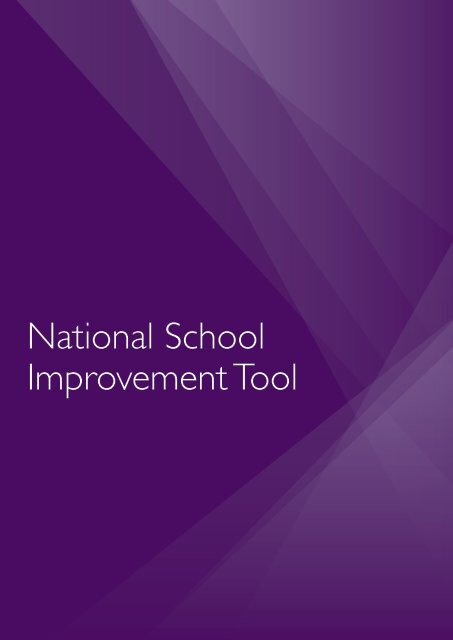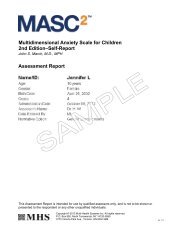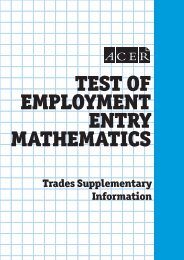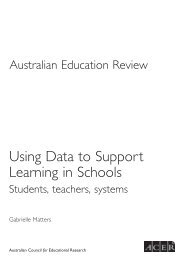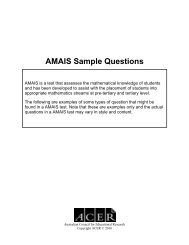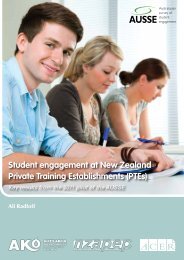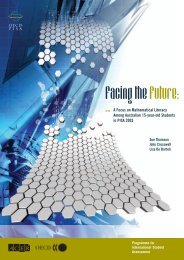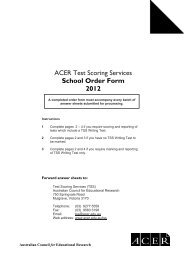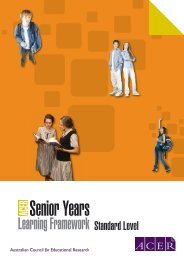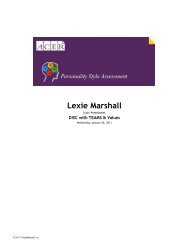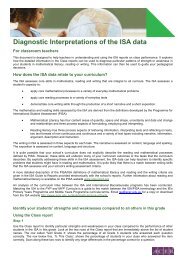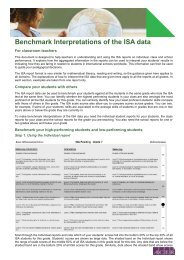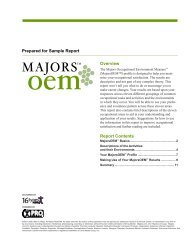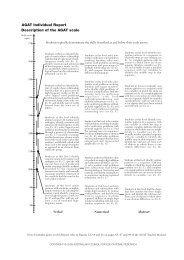National School Improvement Tool - ACER
National School Improvement Tool - ACER
National School Improvement Tool - ACER
You also want an ePaper? Increase the reach of your titles
YUMPU automatically turns print PDFs into web optimized ePapers that Google loves.
<strong>National</strong> <strong>School</strong><br />
<strong>Improvement</strong> <strong>Tool</strong>
ISBN<br />
978-1-74286-198-2 [hardcopy]<br />
978-1-74286-199-9 [PDF]<br />
The <strong>National</strong> <strong>School</strong> <strong>Improvement</strong> <strong>Tool</strong> (tool) was developed by the Australian Council for Educational<br />
Research for the Commonwealth Department of Education, Employment and Workplace Relations based on a<br />
series of national consultations conducted during 2012.<br />
This tool incorporates material developed by Professor Geoff Masters for the Australian Council for Educational<br />
Research in collaboration with the Queensland Department of Education, Training and Employment.<br />
Copyright © State of Queensland (Department of Education, Training and Employment) and the Australian<br />
Council for Educational Research 2012.<br />
www.acer.edu.au/nsit
Contents<br />
Foreword ............................................................................................................................................................1<br />
1 An explicit improvement agenda ..........................................................................................................2<br />
2 Analysis and discussion of data ..............................................................................................................4<br />
3 A culture that promotes learning .........................................................................................................6<br />
4 Targeted use of school resources .........................................................................................................8<br />
5 An expert teaching team ....................................................................................................................... 10<br />
6 Systematic curriculum delivery ............................................................................................................ 12<br />
7 Differentiated teaching and learning ................................................................................................ 14<br />
8 Effective pedagogical practices ............................................................................................................ 16<br />
9 <strong>School</strong>-community partnerships ........................................................................................................ 18
Foreword<br />
Research is revealing the powerful impact that school<br />
leadership teams can have in improving the quality of<br />
teaching and learning. Effective leaders create cultures<br />
of high expectations, provide clarity about what teachers<br />
are to teach and students are to learn, establish strong<br />
professional learning communities and lead ongoing<br />
efforts to improve teaching practices.<br />
The <strong>National</strong> <strong>School</strong> <strong>Improvement</strong> <strong>Tool</strong> was endorsed by<br />
the Standing Council on <strong>School</strong> Education and Early<br />
Childhood (SCSEEC) at its meeting on 7 December 2012<br />
and has been made available to all Australian schools for<br />
use in their school improvement planning from 2013.<br />
The <strong>National</strong> <strong>School</strong> <strong>Improvement</strong> <strong>Tool</strong> brings together<br />
findings from international research into the practices<br />
of highly effective schools and school leaders. The <strong>Tool</strong><br />
assists schools to review and reflect on their efforts to<br />
improve the quality of classroom teaching and learning.<br />
It supports school-wide conversations – including with<br />
parents and families, school governing bodies, local<br />
communities and students themselves – about aspects of<br />
current practice, areas for improvement and evidence that<br />
progress is being made.<br />
The <strong>Tool</strong> does not describe everything that effective<br />
schools do, but focuses on those practices that are most<br />
directly related to school-wide improvements, and thus<br />
outcomes for students. In this sense, the <strong>Tool</strong> can be<br />
thought of as a core element of more comprehensive<br />
school improvement programs, frameworks and<br />
initiatives.<br />
The ultimate goal of school improvement is to improve<br />
outcomes for students, including levels of achievement<br />
and wellbeing. For this reason, direct measures of student<br />
outcomes are essential to all school improvement efforts.<br />
However, ‘school improvement’ fundamentally means<br />
improving what a school does. The <strong>Tool</strong> provides evidence<br />
about a school’s day-to-day work to complement, and<br />
possibly shed light on, measures of student outcomes.<br />
The <strong>Tool</strong> consists of nine inter-related ‘domains’. Although<br />
the <strong>Tool</strong> has been designed to enable a judgement in<br />
relation to each domain separately, experience suggests<br />
that the most effective way to use the <strong>Tool</strong> is to make<br />
observations and gather evidence broadly about a school’s<br />
practices before focusing on individual domains. <strong>School</strong>s<br />
may then decide to give priority to particular domains in<br />
their improvement efforts.<br />
A key feature of the <strong>Tool</strong> is the set of performance levels,<br />
‘Low’, ‘Medium’, ‘High’ and ‘Outstanding’. These levels<br />
enable schools to make judgements about where they<br />
are on their improvement journeys, to set goals and<br />
design strategies for improvement, and to monitor and<br />
demonstrate school improvement over time.<br />
Further information about the <strong>Tool</strong> and its use is provided<br />
in this booklet.<br />
1
1<br />
An explicit<br />
improvement<br />
agenda<br />
The school leadership team and/or governing body have established and are<br />
driving a strong improvement agenda for the school, grounded in evidence from<br />
research and practice and expressed in terms of improvements in measurable<br />
student outcomes. Explicit and clear school-wide targets for improvement have<br />
been set and communicated to parents and families, teachers and students, with<br />
accompanying timelines.<br />
The assessment of this domain includes<br />
consideration of the extent to which:<br />
•§<br />
the governing body, school principal and<br />
other school leaders are united, committed<br />
to and explicit about their core objective<br />
– to improve learning outcomes for all<br />
students in the school;<br />
•§<br />
the school has made an effort to<br />
understand current student achievement<br />
levels, and how achievement levels have<br />
changed over time, including for students<br />
in social inclusion priority groups,<br />
students at risk of disengaging or who<br />
have disengaged from schooling, and<br />
students facing disadvantage, including<br />
students with a disability, those from non-<br />
English speaking backgrounds, Aboriginal<br />
and Torres Strait Islander students, those<br />
from low-SES backgrounds and regional<br />
and remote areas;<br />
•§<br />
explicit targets for improvement in student<br />
achievement levels have been set and<br />
communicated to parents, staff and the<br />
wider school community;<br />
•§<br />
school staff are united in their<br />
commitment to improve the quality of<br />
teaching and learning throughout the<br />
school and to address obstacles to schoolwide<br />
improvement;<br />
•§<br />
the school communicates clearly that it<br />
expects all students to learn successfully<br />
and has high expectations for student<br />
attendance, engagement and outcomes;<br />
•§<br />
the school has clearly articulated<br />
strategies for improving levels of student<br />
achievement and wellbeing; and<br />
•§<br />
progress towards targets is monitored and<br />
initiatives and programs are systematically<br />
evaluated for their effectiveness in<br />
producing desired improvements in<br />
student learning and performance.<br />
2
Outstanding<br />
The school leadership group, including, where appropriate, the governing council, has developed and is driving an<br />
explicit and detailed local school improvement agenda. This agenda is expressed in terms of specific improvements<br />
sought in student performances, is aligned with national and/or system-wide improvement priorities and includes clear<br />
targets with accompanying timelines which are rigorously actioned.<br />
The school improvement agenda has been effective in focusing, and to some extent narrowing and sharpening, the whole<br />
school’s attention on core learning priorities.<br />
There is a strong and optimistic commitment by all staff to the school improvement strategy and a clear belief that<br />
further improvement is possible. Teachers take responsibility for changes in practice required to achieve school targets<br />
and are using data on a regular basis to monitor the effectiveness of their own efforts to meet those targets.<br />
High<br />
The school has developed an agenda for improvement in partnership with parents and the community and school<br />
leaders can describe the improvements they wish to see in student behaviours and outcomes. This agenda is<br />
communicated in staff meetings, school newsletters, parent-teacher meetings and on the school website using a variety<br />
of formats to suit local needs.<br />
The leadership team has analysed school performance data over a number of years and is aware of trends in student<br />
achievement levels. Targets for improvement are clear and accompanied by timelines.<br />
The school leadership team is clearly committed to finding ways to improve on current student outcomes. This is<br />
reflected in an eagerness to learn from research evidence, international experience and from other schools that have<br />
achieved significant improvements.<br />
There is evidence of a school-wide commitment to every student’s success and staff of the school tell stories of significant<br />
student improvement.<br />
Medium<br />
The principal and other school leaders articulate a shared commitment to improvement, but limited attention has been<br />
given to specifying detail or to developing a school-wide approach (eg, plans for improvement may lack coherence, be<br />
short term or without a whole-school focus). Plans for improvement do not appear to have been clearly communicated,<br />
widely implemented or to have impacted significantly on teachers’ day-to-day work. Targets for improvement are not<br />
specific (eg, not accompanied by timelines).<br />
The school’s focus on data is driven more by external requirements (eg, NAPLAN, My <strong>School</strong>) than by an internal desire<br />
for good information to guide school decision making and to monitor progress.<br />
Although there is an expressed commitment to improvement, this is not reflected in a high level of enthusiasm for<br />
personal change on the part of staff. The communication of performance data to the school community tends to be<br />
sporadic and/or is limited only to information that the school is required to report.<br />
Low<br />
There is no obvious plan for improving on current achievement levels. <strong>School</strong> leaders appear to be more focused on<br />
day-to-day operational matters than on analysing and understanding school data, setting targets for whole-school<br />
improvement or communicating an improvement agenda to the school community.<br />
Minimal attention is paid to data and there is very limited communication of school results or of intentions for<br />
improvement to parents, families and the wider school community.<br />
Expectations for significant school improvement are low and staff tend to ‘explain’ current achievement levels in terms<br />
of students’ socioeconomic backgrounds and/or geographical location. There is little evidence that the staff of the school<br />
have a shared commitment to improving outcomes for every student, and this appears to be contributing to a culture<br />
of underperformance. There is little evidence that the school is looking to external sources to identify evidence-based<br />
strategies for improvement.<br />
3
2<br />
Analysis and<br />
discussion of<br />
data<br />
A high priority is given to the school-wide analysis and discussion of<br />
systematically collected data on student outcomes, including academic,<br />
attendance and behavioural outcomes, and student wellbeing. Data analyses<br />
consider overall school performance as well as the performances of students<br />
from identified priority groups; evidence of improvement/regression over time;<br />
performances in comparison with similar schools; and, in the case of data from<br />
standardised tests, measures of growth across the years of school.<br />
The assessment of this domain includes<br />
consideration of the extent to which:<br />
•§<br />
the school has developed and is<br />
implementing a plan for the systematic<br />
collection of a range of student outcome<br />
data including both test data and quality<br />
classroom assessments;<br />
•§<br />
the school has identified and can<br />
demonstrate that it is using tests and other<br />
assessment tools to monitor school-wide<br />
achievement and progress in areas of<br />
national focus such as literacy, numeracy,<br />
science, cross-curricular skills and<br />
attributes, and levels of student resilience,<br />
wellbeing, and social and emotional<br />
development;<br />
•§<br />
the school uses data to identify starting<br />
points for improvement and to monitor<br />
progress over time;<br />
•§<br />
arrangements have been put in place for<br />
the collection and analysis of school-wide<br />
data and for summarising, displaying and<br />
communicating data, including to parents<br />
and the school community;<br />
•§<br />
all teaching staff have access to a broad<br />
range of student achievement and wellbeing<br />
data and use it to analyse, study and display<br />
individual and cohort progress;<br />
•§<br />
professional development is provided<br />
to build staff skills in analysing and<br />
interpreting data;<br />
•§<br />
school leaders, as part of their<br />
responsibilities, regularly work with their<br />
teams to review achievement data relating<br />
to their areas;<br />
•§<br />
time is set aside for in-depth staff<br />
discussions of achievement data and of<br />
strategies for the continuous improvement<br />
of student outcomes;<br />
•§<br />
the school includes in its data gathering<br />
input and feedback from students and<br />
parents;<br />
•§<br />
the school systematically monitors other<br />
performance data, including data relating<br />
to student attendance, school disciplinary<br />
absences and other behavioural data, school<br />
completion, student destinations and<br />
stakeholder perceptions and engagement;<br />
•§<br />
data are used in building a culture of<br />
self-evaluation and reflection across the<br />
school; and<br />
•§<br />
the school uses data to inform school-level<br />
decisions, interventions and initiatives.<br />
4
Outstanding<br />
The principal and other school leaders clearly articulate their belief that reliable data on student outcomes are crucial to<br />
the school’s improvement agenda. The school has established and is implementing a systematic plan for the collection,<br />
analysis and use of a range of student achievement and wellbeing data. Test data in areas such as literacy, numeracy and<br />
science are key elements of this plan.<br />
Data are used throughout the school to identify gaps in student learning, to monitor improvement over time and to<br />
monitor growth across the years of school. A high priority has been given to professional development aimed at building<br />
teachers’ and leaders’ data literacy skills. Staff conversations and language reflect a sophisticated understanding of<br />
student assessment and data concepts (eg, value-added; growth; improvement; statistical significance).<br />
Teachers are given test data for their classes electronically and are provided with, and use, software to analyse, display<br />
and communicate data on individual and class performances and progress, including comparisons of pre- and post-test<br />
results. Teachers routinely use objective data on student achievement as evidence of successful teaching.<br />
High<br />
There is evidence that the principal and other school leaders view reliable and timely student data as essential to their<br />
effective leadership of the school. There is a documented school plan and timetable for the annual collection of data on<br />
student achievement and wellbeing.<br />
One or more members of staff have been assigned responsibility for implementing the annual plan, analysing the full<br />
range of school data, and summarising, displaying and communicating student outcome data for the school. The school<br />
has ensured that appropriate software is available and that at least these assigned staff have been trained to undertake<br />
data analyses.<br />
Time is set aside (eg, on pupil free days and in staff meetings) for the discussion of data and the implications of data<br />
for school policies and classroom practices. These discussions occur at whole-school and team levels. The school can<br />
illustrate through case studies, meeting minutes and project plans how data have been used to identify priorities, take<br />
action and monitor progress.<br />
Medium<br />
<strong>School</strong> leaders pay close attention to data provided to them about the performance of the school (eg, NAPLAN results;<br />
Year 12 results) and identify areas in which the school is performing relatively poorly or well.<br />
Tests (eg, commercially available reading tests) may be used by some teachers, but generally are not used as part of a<br />
whole-school assessment strategy.<br />
An ad hoc approach exists to building staff skills in the analysis, interpretation and use of classroom data.<br />
Software may be used for the analysis of school results, including the performances of priority groups, but analyses<br />
generally do not extend to studies of improvement or growth.<br />
<strong>School</strong> data are presented to staff in meetings, but presentations tend to be ‘for information’ rather than a trigger<br />
for in-depth discussions of teaching practices and school processes. Information about the school’s performance is<br />
communicated to the school community, but may lack explanation or analysis. There is limited engagement with parents<br />
and families around school data.<br />
Low<br />
There is very little evidence of school leaders’ practical use of school-wide student outcome data. There is either no<br />
annual data collection plan for the school or the plan is being implemented in a minimalist fashion. The school makes<br />
little or no use of tests beyond those that the school is required to use.<br />
Teachers do not systematically analyse test and other data for their classes and teachers make little use of data to reflect<br />
on their teaching. The school is unable to demonstrate how data have been used in meetings or with parents to analyse<br />
and discuss current achievement levels and strategies for improvement.<br />
5
3<br />
A culture<br />
that promotes<br />
learning<br />
The school is driven by a deep belief that every student is capable of successful<br />
learning. A high priority is given to building and maintaining positive and caring<br />
relationships between staff, students and parents. There is a strong collegial<br />
culture of mutual trust and support among teachers and school leaders and<br />
parents are treated as partners in the promotion of student learning and<br />
wellbeing. The school works to maintain a learning environment that is safe,<br />
respectful, tolerant, inclusive and that promotes intellectual rigour.<br />
The assessment of this domain includes<br />
consideration of the extent to which:<br />
•§<br />
the school promotes and maintains<br />
an environment reflective of its high<br />
expectations that all students will learn<br />
successfully;<br />
•§<br />
the staff of the school demonstrate an<br />
understanding of the importance of<br />
positive and caring relationships to<br />
successful learning, and work to build<br />
mutually respectful relationships across<br />
the school community;<br />
•§<br />
interactions between staff, students,<br />
parents and families are caring, polite and<br />
inclusive;<br />
•§<br />
the school views parents and families<br />
as integral members of the school<br />
community and partners in student<br />
learning;<br />
•§<br />
the school places a high priority on<br />
student and staff wellbeing and has<br />
processes in place to provide both<br />
academic and non-academic support to<br />
address individual needs;<br />
•§<br />
the school appreciates and values students’<br />
varying cultural backgrounds and works<br />
to build the cultural competence of school<br />
staff;<br />
•§<br />
the school has clear strategies to promote<br />
appropriate behaviour - including<br />
agreed responses and consequences for<br />
inappropriate student behaviour - and<br />
the school provides sufficient support for<br />
teachers to implement these policies;<br />
•§<br />
the school works to create an attractive<br />
and stimulating physical environment that<br />
supports and encourages learning;<br />
•§<br />
the school promotes a culture of inquiry<br />
and innovation, where creative exploration<br />
and independent learning are valued; and<br />
•§<br />
all students and staff have an obvious<br />
sense of belonging, all parents are<br />
welcomed and all staff, students and<br />
parents speak highly of the school.<br />
6
Outstanding<br />
The school ethos is built around high expectations and a commitment to excellence. There is an expectation that every<br />
student will learn and achieve positive outcomes. Classrooms are calm but busy and interruptions to teaching time are<br />
kept to a minimum. There are no obvious behavioural problems, very high rates of school attendance and engagement,<br />
and staff morale is sustained at a high level. There is a happy, optimistic feel to the school.<br />
High levels of trust are apparent across the school community. Interactions are focused on the learning and wellbeing<br />
of students and on continually improving the school’s ability to meet the needs of all students. Parents and families are<br />
valued as partners in student learning, and parents, school leaders and teachers work together in mutually supportive<br />
ways. There is a strong sense of belonging and pride in the school.<br />
A strong collegial culture has been established. Teachers have an overt and shared commitment to the improvement of<br />
teaching and an openness to critique by colleagues. This is reflected in the fact that teachers regularly invite leaders and<br />
colleagues to visit their classrooms to observe their teaching.<br />
High<br />
The ‘tone’ of the school reflects a school-wide commitment to purposeful, successful learning. There are very few<br />
obvious behavioural, attendance or engagement problems and behaviour management takes up very little, if any, time of<br />
school leaders and classroom teachers.<br />
There is a strong focus on quality learning and on the creation of a culture in which all students are expected to learn<br />
successfully, in their own ways and at their own pace. Individual talents are valued. Class ‘busy work’ is kept to a<br />
minimum, and an attempt is made to ensure that all students are engaged in challenging, meaningful learning.<br />
Respectful and caring relationships are reflected in the ways in which staff, students and parents interact and in the<br />
language they use in both formal and informal settings.<br />
Parents and families are encouraged to take a genuine and close interest in the work of the school and are welcomed as<br />
partners in their children’s learning. There are agreed guidelines on such matters as greeting visitors, taking messages,<br />
and responding to queries promptly and respectfully.<br />
Staff morale is generally high.<br />
Medium<br />
Classrooms are generally orderly, although some are more so than others. Non-attendance is an issue for a small<br />
minority of students. However, many other students appear to be minimally engaged in productive learning activities.<br />
The school effectively implements its policies, for example, by ensuring that disruptive behaviour, bullying and<br />
harassment are dealt with promptly. The school has clear expectations for how students should behave and interact<br />
with one another, and in the main, relationships are caring and respectful. Some staff time is taken up dealing with<br />
behaviour problems.<br />
Most parents take an obvious interest in their children’s learning. Engagement is primarily through regularly scheduled<br />
parent-teacher interviews.<br />
Staff morale is satisfactory.<br />
Low<br />
Behavioural problems, disengagement and non-attendance are issues for a significant proportion of students. In a<br />
number of classrooms students are clearly not engaged in productive learning activities.<br />
The school may have policies and agreed procedures relating to student behaviour but these appear to have had little<br />
impact in practice. Much of the time of school leaders and teachers is taken up dealing with inappropriate behaviour.<br />
Interactions between parents, staff and students are not always productive and respectful. Staff tend not to value or<br />
engage parents as partners in student learning.<br />
Some teachers appear to work in isolation from colleagues. Staff morale is low and staff turnover is high.<br />
7
4<br />
Targeted use of<br />
school resources<br />
The school applies its resources (staff time, expertise, funds, facilities, materials)<br />
in a targeted manner to meet the learning and wellbeing needs of all students. It<br />
has school-wide policies, practices and programs in place to assist in identifying<br />
and addressing student needs. Flexible structures and processes enable the<br />
school to respond appropriately to the needs of individual learners.<br />
The assessment of this domain includes<br />
consideration of the extent to which:<br />
•§<br />
the school has processes to identify and<br />
respond to student needs through the<br />
allocation of staff and resources;<br />
•§<br />
staff are deployed in ways that best address<br />
the learning needs of all students in the<br />
school and that make best use of available<br />
staff expertise and interests;<br />
•§<br />
there are school-wide programs and<br />
approaches for students requiring<br />
additional or specialist support;<br />
•§<br />
in its use of discretionary school funds, the<br />
school gives priority to initiatives aimed at<br />
improving outcomes for students;<br />
•§<br />
flexible curriculum delivery arrangements<br />
have been established to enable staff to<br />
better address the needs of individual<br />
learners;<br />
•§<br />
the school effectively uses its physical<br />
environment and available facilities to<br />
maximise student learning; and<br />
•§<br />
the school budget aligns local and system<br />
priorities.<br />
8
Outstanding<br />
The principal and other school leaders have given a very high priority to understanding and addressing the learning<br />
needs of all students in the school. This is reflected in the implementation of systematic strategies for identifying student<br />
needs and the development of creative school-wide solutions for addressing those needs.<br />
A school-wide process has been established for identifying specific student learning needs. This process includes<br />
systematic testing to establish learning gaps and special needs. <strong>School</strong> records of individual student needs, achievements<br />
and progress are maintained centrally and shared across year levels.<br />
A range of initiatives (eg, across-class and across-grade groupings for literacy and numeracy; the sharing of specialist<br />
teachers with neighbouring schools, if they exist) is being implemented to make more effective use of available resources<br />
to enhance teaching and learning. The school deploys staff in ways that make best use of their expertise (eg, specialist<br />
reading/science teachers).<br />
High<br />
The principal and other school leaders have introduced programs and strategies to identify and address the needs of<br />
students in the school and are sourcing and applying available resources to meet those needs.<br />
The school has developed processes (eg, systematic testing and assessment) for identifying student learning needs,<br />
although there may not always be good school records of student achievement and progress.<br />
Programs to meet individual learning needs (eg, programs for gifted students, students with learning difficulties,<br />
students for whom English is a second language, Indigenous students, refugees) are prioritised, where possible, in the<br />
school budget.<br />
Physical spaces and technology are used effectively to maximise student learning. Learning spaces are organised for<br />
whole group work, small group work and individual work.<br />
Medium<br />
The school uses its human and physical resources to address the needs of students, although this may not be preceded by<br />
a systematic analysis of those needs.<br />
Specialist diagnostic testing is organised for a small number of students with special needs, but teachers do not routinely<br />
administer tests to better understand specific learning difficulties (eg, problems in learning to read) or individual<br />
learning needs (eg, LBOTE, gifted).<br />
There are very few school-wide programs or policies designed to address the learning needs of particular student<br />
groups (eg, gifted students, students with disabilities, students for whom English is a second language). <strong>School</strong> leaders<br />
encourage teachers to address individual learning needs in classrooms, but there are very few agreed school-wide<br />
strategies for doing this.<br />
Physical learning spaces are used creatively and technology is accessible to the majority of staff and students.<br />
Low<br />
The improvement of student outcomes does not appear to be the driving consideration in the<br />
allocation of school resources (eg, the use of discretionary school funds).<br />
There is very little, if any, systematic testing of students to identify individual learning needs.<br />
The school does not always make best use of available staff expertise.<br />
<strong>School</strong> leaders have developed very few, if any, school-wide policies or programs to address individual needs, which are<br />
left to classroom teachers.<br />
<strong>School</strong> learning spaces tend to be used traditionally, with limited flexibility to support different kinds of learners and<br />
learning.<br />
9
5<br />
An expert<br />
teaching team<br />
The school has found ways to build a school-wide, professional team of highly<br />
able teachers, including teachers who take an active leadership role beyond<br />
the classroom. Strong procedures are in place to encourage a school-wide,<br />
shared responsibility for student learning and success, and to encourage the<br />
development of a culture of continuous professional improvement that includes<br />
classroom-based learning, mentoring and coaching arrangements.<br />
The assessment of this domain includes<br />
consideration of the extent to which:<br />
•§<br />
the school places a priority on attracting,<br />
retaining and developing the best possible<br />
teachers;<br />
•§<br />
the leadership team has strategies in place<br />
to assist teachers to continue to develop<br />
and share deep understandings of how<br />
students learn subjects/content, including<br />
pre-requisite skills and knowledge,<br />
common student misunderstandings and<br />
errors, learning difficulties and effective<br />
interventions;<br />
•§<br />
teachers in the school are experts in the<br />
fields in which they teach, have high levels<br />
of confidence in teaching in those fields<br />
and are eager to expand their subject<br />
knowledge to learn how to improve on<br />
their current teaching practices;<br />
•§<br />
the school expects all teachers to be<br />
highly committed to the continuous<br />
improvement of their own teaching and<br />
to be focused on the development of<br />
knowledge and skills required to improve<br />
student learning;<br />
•§<br />
the principal and other school leaders lead<br />
and model professional learning in the<br />
school;<br />
•§<br />
the principal and other school leaders<br />
build networked school relationships<br />
that support leadership development,<br />
including principal-principal mentoring<br />
relationships;<br />
•§<br />
school leaders ensure that opportunities<br />
are created for teachers to work together<br />
and to learn from each other’s practices,<br />
including through online professional<br />
communities;<br />
•§<br />
the school works to ensure the continuity<br />
of a culture of collaboration and<br />
teamwork over time across cohorts of<br />
teachers;<br />
•§<br />
the school uses agreed formal processes to<br />
manage unsatisfactory performance; and<br />
•§<br />
the school has in place a professional<br />
learning plan and associated budget to<br />
support local and, where appropriate,<br />
system priorities.<br />
10
Outstanding<br />
The teaching staff of the school are experts in the fields in which they teach and have very high levels of pedagogical<br />
knowledge and skill, including expert knowledge of evidence-based teaching strategies.<br />
Teachers and school leaders take personal and collective responsibility for improving student learning and wellbeing,<br />
working together and learning from each other’s practices. The sharing and showcasing of best practice are common.<br />
In team meetings there is an emphasis on the joint analysis of student work and on teaching strategies for improving<br />
student learning. Teachers collaboratively plan, deliver and review the effectiveness of lessons.<br />
<strong>School</strong> leaders place a very high priority on the ongoing professional learning of all staff and on the development of a<br />
school-wide, self-reflective culture focused on improving classroom teaching.<br />
<strong>School</strong> leaders participate in professional learning activities, learning alongside teachers, and the school supports<br />
teachers to continue formal study and celebrates professional success.<br />
High<br />
There is evidence that the principal and other school leaders see the development of staff into an expert and coherent<br />
school-wide teaching team as central to improving outcomes for all students.<br />
There is a documented professional learning plan and the school has arrangements in place for mentoring and coaching.<br />
Teachers visit each other’s classrooms and welcome opportunities to have principals and other school leaders observe<br />
and discuss their work with them.<br />
Attention is paid to strengths and weaknesses in the school-wide team, with strategies in place to recruit staff with<br />
particular expertise, to train staff to address particular needs, and to support staff who find it difficult to commit to the<br />
school’s improvement agenda.<br />
The school provides opportunities for teachers to take on leadership roles outside the classroom.<br />
Medium<br />
The school undertakes professional learning activities, although these may not always focus on the development of<br />
knowledge and skills required to improve student learning and there may not be a coherent, documented learning plan.<br />
The principal and leadership team are seen as supportive of, but not generally involved in, the day-to-day practice and<br />
learning of teachers.<br />
Teachers are open to constructive feedback and provide feedback to colleagues, although there may not be formal<br />
mentoring or coaching arrangements in place.<br />
The school is implementing a formal process for conducting professional discussions with staff.<br />
The school’s professional learning agenda is made explicit to staff at induction, and in staff handbooks.<br />
Where it is necessary to manage unsatisfactory staff performance, this is done professionally and effectively, and in<br />
accordance with agreed guidelines.<br />
Low<br />
The development of a professional school-wide team does not appear to be a driving consideration of the principal<br />
or other school leaders (eg, no reference is made to the <strong>National</strong> Professional Standards for Teachers, there are no<br />
mentoring arrangements in place, teachers work largely in isolation from one another ‘behind closed doors’).<br />
There is little evidence that school leaders are proactive in the recruitment and retention of staff.<br />
There is little sense of a whole-school coordinated approach to professional learning and a low priority is given to<br />
enhancing staff performance.<br />
11
6<br />
Systematic<br />
curriculum<br />
delivery<br />
The school has a coherent, sequenced plan for curriculum delivery that ensures<br />
consistent teaching and learning expectations and a clear reference for monitoring<br />
learning across the year levels. The plan, within which evidence-based teaching<br />
practices are embedded, and to which assessment and reporting procedures are<br />
aligned, has been developed with reference to the Australian Curriculum or other<br />
approved curriculum and refined collaboratively to provide a shared vision for<br />
curriculum practice. This plan is shared with parents and families.<br />
The assessment of this domain includes<br />
consideration of the extent to which:<br />
•§<br />
the school has an explicit, coherent,<br />
sequenced plan for curriculum delivery<br />
across the years of school which makes<br />
clear what (and when) teachers should<br />
teach and students should learn;<br />
•§<br />
the plan for curriculum delivery is shared<br />
with parents, families and the wider<br />
community and feedback is sought on<br />
ways to make the school curriculum<br />
responsive to local needs;<br />
•§<br />
staff of the school are familiar with<br />
and work within the school’s shared<br />
curriculum expectations;<br />
•§<br />
the curriculum is used as a basis for ongoing<br />
staff discussions about the best ways to<br />
maximise student learning and wellbeing;<br />
•§<br />
school leaders focus attention and energy<br />
on priority curriculum areas and on<br />
ensuring that all students are proficient<br />
in the basics, as well as on the appropriate<br />
key learning areas in Years 10-12;<br />
•§<br />
the school curriculum includes a strong<br />
focus on the development of crosscurricular<br />
skills and attributes such as<br />
literacy, numeracy, information and<br />
communication technology capability,<br />
critical and creative thinking, personal and<br />
social capability, ethical behaviour and<br />
intercultural understanding.;<br />
•§<br />
a priority is given to constructing learning<br />
experiences that are accessible, engaging<br />
and challenging for all students, including<br />
those with particular needs;<br />
•§<br />
the school places a priority on making the<br />
curriculum locally relevant and adopts a<br />
strengths-based approach to recognising,<br />
valuing and building on students’ existing<br />
knowledge and skills;<br />
•§<br />
assessment processes are aligned with the<br />
curriculum and are designed to clarify<br />
learning intentions, establish where<br />
individual students are in their learning,<br />
diagnose details of student learning (eg,<br />
gaps in knowledge and understanding),<br />
and to monitor learning progress across<br />
the years of school;<br />
•§<br />
reporting processes are aligned with the<br />
curriculum and designed to provide<br />
parents, families and students themselves<br />
with information about the achievement<br />
of curriculum intentions and progress<br />
over time; and<br />
•§<br />
professional development is provided to<br />
build staff skills in curriculum planning<br />
and development.<br />
12
Outstanding<br />
The school has a clearly documented whole-school plan for curriculum delivery. This plan is aligned with the Australian<br />
or other approved curriculum and, where appropriate, system curriculum documents. The plan makes explicit what<br />
(and when) teachers should teach and students should learn. The curriculum delivery plan is being implemented<br />
throughout the school and is shared with parents and the wider community.<br />
A strong alignment has been achieved between the overall curriculum delivery plan, term and unit plans, classroom<br />
teaching and the regular assessment of student progress in relation to curriculum expectations.<br />
Considerable attention has been given to ensuring ‘vertical’ alignment of the curriculum so that there is continuity and<br />
progression of learning across the years of school, with teaching in each year building on to and extending learning in<br />
previous years. General capabilities and cross-curriculum priorities are understood, valued and used as active learning<br />
streams for all students.<br />
A high priority in curriculum planning is given to the progressive development of students’ deep understandings of<br />
concepts, principles and big ideas within learning areas, as well as to the ongoing development of cross-curricular skills<br />
and attributes, including teamwork, critical thinking, problem solving, and the evaluation of information and evidence.<br />
The school places a priority on making the curriculum locally relevant and accessible to all students and values and builds on<br />
to students’ existing knowledge and varying backgrounds.<br />
High<br />
The school’s curriculum delivery plan identifies curriculum, teaching and learning priorities and requirements. The<br />
curriculum delivery plan reflects a shared vision (by the school’s governing body, principal, school leadership team,<br />
and teachers) for the school, and provides a context for delivering the curriculum as detailed in the Australian or other<br />
approved curriculum and, where relevant, system curriculum documents.<br />
The school curriculum plan and curriculum delivery (including the time allocated to particular learning) balance requirements<br />
to address all learning areas, to give priority to English, mathematics and science, and to embed the fundamental skills of literacy,<br />
numeracy and higher order thinking in all school subjects.<br />
The school leadership team ensures that the enacted curriculum remains a focus for discussion among, and<br />
collaboration between, teachers and that the curriculum plan is the reference against which flexible delivery is designed,<br />
assessment tasks are developed and student learning is reported. Curriculum delivery is designed to meet the needs of<br />
the range of students within each year level as well as those with disabilities and other particular needs.<br />
Medium<br />
The school has a documented plan for curriculum delivery that includes year level and term plans, but the progression of<br />
learning from year to year is not always obvious and the relationship between the pieces of the plan (the year, term and unit<br />
plans) would benefit from further clarification.<br />
<strong>School</strong> leaders talk about embedding fundamental cross-curricular skills such as literacy, numeracy and higher order<br />
thinking within all subjects, but there is little evidence that school-wide strategies are in place to drive a consistent<br />
approach. Literacy tends to be seen as the responsibility of English teachers and numeracy, the responsibility of<br />
mathematics teachers.<br />
Discussions about curriculum delivery tend to be sporadic and reactive with a year level focus rather than being driven<br />
by a leadership team with a whole-school approach.<br />
Low<br />
<strong>School</strong> leaders and teachers have limited familiarity with national or system-wide curriculum documents.<br />
The school may have a documented plan for curriculum delivery but there is little evidence that the whole-school plan<br />
drives the lesson plans of individual teachers.<br />
The enacted school curriculum is not seen as a central concern of all teachers (eg, it is not a regular topic of conversation,<br />
a focus for assessment design or a framework against which student learning is reported).<br />
13
7<br />
Differentiated<br />
teaching and<br />
learning<br />
The school places a high priority on ensuring that, in their day-to-day teaching,<br />
classroom teachers identify and address the learning needs of individual students,<br />
including high-achieving students. Teachers are encouraged and supported to<br />
monitor closely the progress of individuals, identify learning difficulties and tailor<br />
classroom activities to levels of readiness and need.<br />
The assessment of this domain includes<br />
consideration of the extent to which:<br />
•§<br />
teaching practices across the school<br />
reflect the belief that, although students<br />
are at different stages in their learning<br />
and may be progressing at different<br />
rates, all students are capable of learning<br />
successfully if motivated and given<br />
appropriate learning opportunities and<br />
necessary support;<br />
•§<br />
teachers work at understanding where<br />
students are in their learning – including<br />
their current knowledge, skills, learning<br />
difficulties and misunderstandings – to<br />
identify starting points for teaching;<br />
•§<br />
teachers work to ensure that all students<br />
– including high-achieving students – are<br />
appropriately engaged, challenged and<br />
extended by designing classroom activities<br />
to meet students’ learning needs, levels<br />
of readiness, interests, aspirations and<br />
motivations;<br />
•§<br />
teachers consult with parents and with<br />
students themselves to ensure that<br />
reasonable adjustments are made to meet<br />
the needs of students with disabilities,<br />
including through the development of<br />
individual learning plans;<br />
•§<br />
teachers closely monitor the progress of<br />
individual students and continually adjust<br />
their teaching in response to the progress<br />
that individuals are making;<br />
•§<br />
teachers encourage and assist students<br />
to monitor their own learning and to set<br />
goals for future learning;<br />
•§<br />
communication with parents and<br />
families provides information about<br />
where students are in their learning,<br />
what progress they have made over time,<br />
and what they might do to support their<br />
children’s further learning; and<br />
•§<br />
tailored, early and sustained interventions<br />
are in place for students identified as<br />
requiring additional support, including<br />
students returning to school after a period<br />
of absence/disengagement.<br />
14
Outstanding<br />
The school leadership team actively promotes the use of differentiated teaching as a strategy for ensuring that every<br />
student is engaged and learning successfully. It is recognised throughout the school that some students require significant<br />
adjustments to their learning programs (eg, accelerated programs, special support) if they are to be optimally engaged<br />
and challenged, and individual learning plans have been developed for those students requiring them. Differentiation is a<br />
priority of the school and a feature of every teacher’s practice.<br />
Regular data on the achievements, progress, strengths and weaknesses of individual students are used in all classrooms to<br />
make judgements about individual needs, to identify appropriate starting points for teaching and to personalise teaching<br />
and learning activities. Reports to parents and carers include details of how learning opportunities have been tailored to<br />
individual needs and of the progress individuals have made.<br />
High<br />
<strong>School</strong> leaders explicitly encourage teachers to tailor their teaching to student needs and readiness. This includes the<br />
systematic use of assessment instruments (standardised assessment tasks and teacher developed assessment tools) to<br />
establish where individuals are in their learning and to identify skill gaps and misunderstandings. Teachers also are<br />
encouraged to respond to differences in cultural knowledge and experiences and to cater for individual differences by<br />
offering multiple means of representation, engagement and expression.<br />
Planning shows how the different needs of students are addressed, and how multiple opportunities to learn are provided,<br />
including multiple pathways for transition to external studies (eg, apprenticeships) for students in Years 10-12. Students’<br />
workbooks also illustrate differentiated tasks and feedback.<br />
Reports to parents show progress over time and include suggestions for ways in which parents can support their<br />
children’s learning.<br />
Medium<br />
<strong>School</strong> leaders are committed to success for all, but do not drive a strong classroom agenda to assess and identify<br />
individual learning needs or to differentiate teaching according to students’ needs.<br />
Some use is made of assessment instruments to identify individual strengths and weaknesses and starting points for<br />
teaching, but this appears to be at the initiative of individual teachers rather than a school-wide expectation.<br />
Some use is made of differentiated teaching (eg, differentiated reading groups in the early primary years), but in most<br />
classes teachers teach the same curriculum to all students with similar levels of individual support.<br />
Regular assessments of student learning are undertaken, but these often are summative and disconnected (eg, relating to<br />
different topics) rather than exploring long-term progress in students’ knowledge, skills and understandings over time.<br />
Reports to parents generally do not show progress or provide guidance to parents on actions they might take.<br />
Low<br />
<strong>School</strong> leaders do not place a high priority on teachers identifying and addressing individual learning needs, but are<br />
more focused on ensuring that all teachers are teaching the core year level curriculum.<br />
Little or no classroom use is made of assessment instruments to establish starting points for teaching. Assessments tend<br />
to be used only to establish summatively how much of the taught content students have learnt.<br />
Teachers tend to teach to the middle of the class, with the expectation that some students will not master the content,<br />
and finding ways to occupy more able students who finish work early.<br />
Reports to parents tend to be summative reports of how students have performed, with little guidance on what parents<br />
might do to assist in their children’s learning.<br />
15
8<br />
Effective<br />
pedagogical<br />
practices<br />
The school principal and other school leaders recognise that highly effective<br />
teaching is the key to improving student learning throughout the school. They<br />
take a strong leadership role, encouraging the use of research-based teaching<br />
practices in all classrooms to ensure that every student is engaged, challenged<br />
and learning successfully. All teachers understand and use effective teaching<br />
methods – including explicit instruction – to maximise student learning.<br />
The assessment of this domain includes<br />
consideration of the extent to which:<br />
•§<br />
the school leadership team keeps abreast<br />
of research on effective teaching practices;<br />
•§<br />
the school leadership team establishes<br />
and communicates clear expectations<br />
concerning the use of effective teaching<br />
strategies throughout the school;<br />
•§<br />
school leaders, including the principal,<br />
spend time working with teachers,<br />
providing feedback on teaching and, where<br />
appropriate, modelling effective teaching<br />
strategies;<br />
•§<br />
school leaders actively promote a range<br />
of evidence-based teaching strategies,<br />
including;<br />
−−<br />
creating classroom and applied learning<br />
environments in which all students are<br />
engaged, challenged, feel safe to take<br />
risks and are supported to learn<br />
−−<br />
connecting new material to past<br />
learning and assisting students to see<br />
the continuity in their learning over<br />
time<br />
−−<br />
demonstrating explicitly what students<br />
are to do, discussing this with students,<br />
and then questioning and checking that<br />
learning is occurring<br />
−−<br />
promoting deep learning by<br />
emphasising underlying principles,<br />
concepts and big ideas that are<br />
developed over time<br />
−−<br />
setting high expectations for every<br />
student’s progress and ambitious targets<br />
for improving classroom performances<br />
−−<br />
working to build students’ beliefs<br />
in their own capacities to learn<br />
successfully and their understanding<br />
of the relationship between effort and<br />
success<br />
−−<br />
providing regular and timely feedback<br />
to students in forms that make clear<br />
what actions individuals can take to<br />
make further learning progress<br />
−−<br />
routinely evaluating the effectiveness of<br />
teaching and using these evaluations to<br />
make adjustments to practice; and<br />
•§<br />
school leaders provide teachers with<br />
ongoing detailed feedback on their<br />
classroom practices.<br />
16
Outstanding<br />
The principal and other school leaders have accepted personal responsibility for driving improvements in teaching<br />
throughout the school. They demonstrate a strong conviction that improved teaching is the key to improved student<br />
learning and have clear and well-known positions on the kinds of teaching that they wish to see occurring.<br />
All teachers and leaders are committed to identifying, understanding and implementing better teaching methods, and<br />
a high priority is given to evidence-based teaching strategies (strategies that have been demonstrated through research<br />
and practice to be highly effective).<br />
<strong>School</strong> leaders spend time working with teachers to improve their teaching practices, including modelling, evaluating<br />
and providing feedback on classroom teaching.<br />
High<br />
<strong>School</strong> leaders are committed to continuous improvement in teaching practices throughout the school and expect team<br />
leaders and teachers to identify ways of doing this, although the principal and other senior leaders may not themselves<br />
have clear positions on the kinds of teaching they wish to see occurring across the school or be ‘hands on’ in driving<br />
improved teaching practices.<br />
There is a particular focus on improved teaching methods in reading, writing, mathematics and science, and professional<br />
learning activities are focused on building teachers’ understandings of highly effective teaching strategies in these areas.<br />
Clarity about what students are expected to learn and be able to do, high expectations of every student’s learning, explicit<br />
teaching of skills and content, individualised attention as required, and timely feedback to guide student action are key<br />
elements of the school’s push for improved teaching and learning.<br />
Medium<br />
<strong>School</strong> leaders are explicit about their desire to see effective teaching occurring throughout the school, but are less clear<br />
about what this might look like. They do not appear to be driving a strong agenda to improve and/or enhance teaching<br />
practices across the school, except perhaps indirectly through a focus on school results and targets. <strong>School</strong> leaders take<br />
a close interest in the school’s literacy and numeracy results, but generally do not engage in discussions with staff about<br />
effective teaching strategies.<br />
Discussions of specific teaching practices are rare and generally occur only in the context of concerns about a teacher’s<br />
performance.<br />
There is some clarity about what students are expected to learn, but a lack of balance in teaching methods (eg, overreliance<br />
on whole-group teaching or very little explicit teaching).<br />
Low<br />
<strong>School</strong> leaders do not appear to have strong views on the characteristics of highly effective teaching. There is little<br />
evidence that they are driving an agenda to change or enhance teaching practices across the school.<br />
The principal and other school leaders spend very little time on issues related to teaching. Questions of pedagogy appear<br />
to be viewed solely as the responsibility of teachers. There is little obvious school-wide discussion or consideration of<br />
highly effective teaching methods.<br />
There may be a lack of explicitness about what students are expected to know and be able to do as a result of classroom<br />
activities, very little explicit teaching, limited attention to individual learning needs, or low expectations on the part<br />
of teachers that all students in the room will master the content of lessons. Classroom activities frequently have the<br />
appearance of ‘busy work’.<br />
17
9<br />
<strong>School</strong>community<br />
partnerships<br />
The school actively seeks ways to enhance student learning and wellbeing by<br />
partnering with parents and families, other education and training institutions,<br />
local businesses and community organisations. Parents and families are recognised<br />
as integral members of the school community and partners in their children’s<br />
education. Partnerships are strategically established to address identified<br />
student needs and operate by providing access to experiences, support and<br />
intellectual and/or physical resources not available within the school. All partners<br />
are committed to the common purposes and goals of partnership activities.<br />
Procedures are in place to ensure effective communications and to monitor and<br />
evaluate the intended impacts of the school’s partnerships.<br />
The assessment of this domain includes<br />
consideration of the extent to which:<br />
•§<br />
the school builds partnerships with<br />
parents, families, local businesses and<br />
community organisations (including<br />
allied health, family support, counselling<br />
and rehabilitation services) to improve<br />
opportunities and outcomes for students;<br />
•§<br />
the school identifies potential community<br />
partners on the basis of their capacity<br />
to contribute to improved student<br />
achievement and/or wellbeing;<br />
•§<br />
identified partners are involved in<br />
collaborative planning and are committed<br />
to the purposes and objectives of the<br />
partnership;<br />
•§<br />
the senior leadership teams in the partner<br />
organisations are involved, committed<br />
and play a role in achieving staff<br />
commitment and participation within<br />
their organisations;<br />
•§<br />
there is clarity around partner roles and<br />
responsibilities;<br />
•§<br />
major partnership decisions are made<br />
collaboratively and partnership activities<br />
are designed to make best use of partners’<br />
expertise;<br />
•§<br />
goals, progress and achievements are<br />
systematically and regularly monitored<br />
and refined as required;<br />
•§<br />
adequate resources are committed to<br />
ensure the effectiveness and success of<br />
partnerships;<br />
•§<br />
the school collects evidence to evaluate<br />
whether partnerships are having their<br />
intended impact in improving outcomes<br />
for students; and<br />
•§<br />
the school’s partnerships are sustainable<br />
and have become an accepted part of the<br />
culture of the school community and<br />
partner organisations.<br />
18
Outstanding<br />
The school leadership team makes deliberate and strategic use of partnerships with families, local businesses and<br />
community organisations to access intellectual, physical and/or other resources not available within the school for the<br />
purposes of improving student outcomes. There is a range of currently operating partnerships, each carefully planned<br />
and designed to enhance student outcomes (for example, to broaden student knowledge, build new skills, develop<br />
more positive attitudes, increase engagement levels, create applied learning opportunities for students, or facilitate<br />
successful transitions to work or further education or training).<br />
Each partnership has been established in response to an identified need. Considerable effort has been put into<br />
understanding students’ needs, identifying appropriate partners to address those needs, planning the details of<br />
partnership programs and clarifying partner roles and responsibilities.<br />
Careful consideration has been given to the benefits of the partnership to each participating partner. Explicit<br />
processes are in place to ensure ongoing and effective communication – sometimes across networks of partners – and<br />
there are documented plans for monitoring and reviewing the effectiveness of each partnership.<br />
The school’s partnerships are being successfully implemented and appear to be adequately resourced and sustainable.<br />
There is clear evidence that partnerships are having their intended impact.<br />
High<br />
The school has established one or more partnerships with families, local businesses and/or community organisations<br />
with the express purpose of improving outcomes for students. Partnerships have generally been initiated by the senior<br />
leadership team and have their support.<br />
Each partnership brings staff and students of the school together with external partners such as families, other<br />
education or training institutions, local businesses and/or community organisations. All partners have a high level of<br />
understanding of, and commitment to, the purposes of the partnership and clear objectives have been set, expressed in<br />
terms of improved outcomes for students.<br />
Attention has been given to communication and to the sharing of experiences within the partnership; however, there<br />
may be no formal plan for reviewing the partnership’s outcomes and effectiveness.<br />
There is evidence that the school’s partnerships are being implemented as intended. However, there may be limited<br />
evidence of improved student outcomes as a result of partnership activities – possibly because there has been insufficient<br />
time for them to demonstrate an effect.<br />
Medium<br />
The school has external ‘partnerships’, but rather than being built around a coherent, jointly planned program of<br />
activities to improve outcomes for students, these ‘partnerships’ tend to be mutually convenient arrangements (eg,<br />
exchanges of expertise or the sharing of facilities between institutions or organisations). Such ‘partnerships’ often are<br />
established by individual members of staff and have limited whole-school support or engagement.<br />
The student needs that partnerships are designed to address may not be made explicit and, rather than being carefully<br />
planned, individual partnerships tend to be opportunistic in nature. Communications between partners are largely<br />
unplanned and infrequent.<br />
No plans exist to systematically review the effectiveness of partnerships, which typically are very dependent on the efforts<br />
of a small number of individuals and so have limited sustainability.<br />
Low<br />
There is no evidence of planned, deliberate partnerships with other institutions or organisations. Contacts with families,<br />
other education and training institutions, local businesses and community organisations, when they occur, are limited<br />
to isolated events. Although references may be made to ‘partnerships’, these partnerships are not based on collaboratively<br />
planned programs of activities with clear goals, roles and responsibilities.<br />
19
Australian Council for Educational Research


